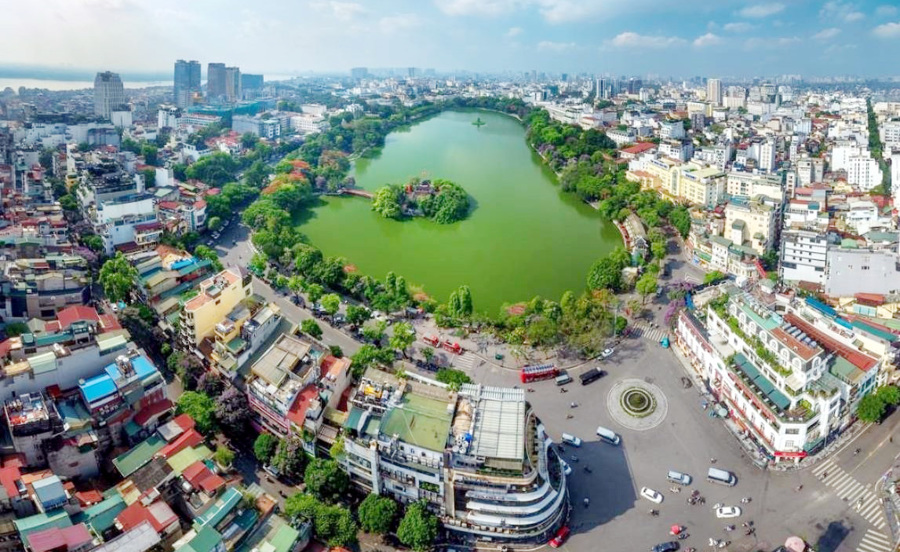In recent years, Ha Noi has focused on urban renovation and rehabilitation, especially the preservation of historical and cultural heritage in downtown areas. Numerous policies and measures have been implemented to achieve these goals.

Ha Noi from above. Photo: Le Khanh/The Hanoi Times
Despite considerable efforts, Ha Noi's urban renovation in the historic inner city has not met expectations, with the area still facing significant development bottlenecks.
Consequently, Politburo, in its latest conclusion No.80-KL/TW, instructed Hanoi to prioritize urban renovation in the historic downtown area, adhering to the principle of integrating preservation and development.
Challenging issues on living standards
According to the development orientation in the Master Plan for Ha Noi’s construction through 2030, with a vision to 2050 approved by the Prime Minister in 2011 (QHC2011), the historic center includes Dong Da, Hoan Kiem, Ba Dinh, and the northern part of Hai Ba Trung and a southern part of Tay Ho District.
This area, which houses the main political and administrative functions of both the nation and Ha Noi, will focus on redevelopment, reorganization of land use functions, and the enhancement of historic urban values. The plan includes upgrading social and technical infrastructure and relocating industrial facilities, warehouses, universities, and government offices.
Moreover, existing housing will be renovated, old apartment blocks will be redeveloped, public transport and urban railways will be expanded, and historical sites and heritage will be preserved. Development of new housing, especially high-rise buildings, will be limited, and population density will be controlled, with the aim of reducing it from 1.2 million to around 0.8 million.
Pham Thi Nham, Deputy Director of the National Institute of Urban and Rural Planning, noted that after the approval of QHC2011, Ha Noi began to draw up sub-zoning plans, including for the four historic inner districts. Additionally, Ha Noi has issued management regulations for critical areas such as the Old Quarter, Hoan Kiem Lake, the Thang Long Imperial Citadel, and the national political center in the Ba Dinh district.
Despite these efforts and various development guidelines and ideas, the area continues to face numerous obstacles. These include a lack of mechanisms to preserve and promote heritage values, increased personal vehicle usage and traffic congestion leading to environmental pollution, the continued construction of large high-rise condominiums, economic activities contributing to greenhouse gas emissions, a scattered and insufficient system of lakes and parks reducing the quality of life, and the failure to reduce population density or relocate industrial, medical, and educational facilities.
Housing issues are particularly pressing, with dilapidated old apartment blocks affecting and undermining living standards and urban aesthetics, yet they are slow to be renovated. In the Old Quarter and other areas, self-constructed or renovated housing often fails to meet urban planning standards or safety regulations, such as fire safety and environmental conditions.
Tran Ngoc Chinh, President of the Vietnam Urban Planning and Development Association, pointed out that the core districts of Ha Noi have high-density residential areas, creating cramped and enclosed living spaces.
“Substandard housing conditions, combined with a lack of public facilities and social services, have a significant impact on residents' safety and health,” he noted.
Addressing bottlenecks as key priority
Experts suggest that the revised Capital Law and the current major urban plans should address these urban development bottlenecks, particularly in the historic inner city.
National Assembly Deputy Hoang Van Cuong from the Ha Noi delegation pointed out that previous legislation had restricted investment in renovation in historic downtown areas, leading to delays in renovating old apartments and self-built homes that fail to meet technical and safety standards. The revised Capital Law must provide a legal framework that distinguishes between areas requiring strict preservation of historical values and those that can be modernized.
Cuong proposed that areas with high population density and many low-rise buildings should be transformed into modern urban areas with fewer high-rise buildings, freeing up land for green spaces, public areas, and transportation development.
“Legal frameworks should enable the utilization of underground and elevated spaces, alongside modern public infrastructure such as high-capacity public transport and urban railways,” he noted.
Nguyen Phuong Thuy, Deputy Head of the National Assembly's Legal Committee, emphasized that a key element of the revised Capital Law and the new urban plans is the development of urban areas based on the Transit-Oriented Development (TOD) model.
“This approach can address not only transportation infrastructure but also urban planning and redevelopment within the inner city,” Thuy said.
With well-developed urban areas providing good living conditions and convenient transportation, residents may be more inclined to leave cramped, substandard living conditions, thus improving the overall quality of life, he said.
“According to international experience and recommendations, urban upgrading and renovation involve improving living conditions in deteriorated and disorganized areas and providing basic services to residents. This includes enhancing or installing essential infrastructure such as water supply, sanitation, solid waste collection, access roads and footpaths, stormwater drainage, street lighting, and other community services.
The upgrading process also addresses land tenure issues and improves housing, as well as access to social services like healthcare and education. Therefore, the goal of urban upgrading is to develop inclusive communities integrated into the city's social and service framework, minimizing physical and social asset loss,” said Nguyen Quang, former UN-Habitat Program Manager in Vietnam.
Ngoc Mai - Vu Le